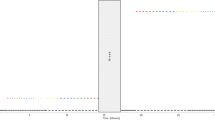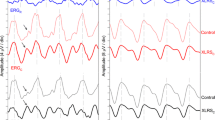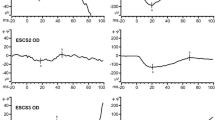Abstract
Fifty patients with all genetic types of retinitis pigmentosa (RP) were tested with the visually evoked cortical potential (VECP) by full-field flashes of blue and red light in the dark-adapted state and white light flashes in the light-adapted state. VECPs were recorded in all but one of these patients, even those with only a few degrees of central visual field remaining. In a subgroup of patients the absence of the VECP to blue light, dark-adapted, was correlated with a final dark-adapted threshold at or above cone threshold. These observations suggest that the VECP may be a useful objective method of assessment of patients with RP especially patients without detectable ERGs.
Similar content being viewed by others
References
Adams WL, Arden GB and Behrman J. (1969) Responses of human visual cortex following excitation of peripheral retinal rods. Br J Ophthalmol 53:439–452
Babel J, Stangos N, Korol S and Spiritus M (1977) The visual evoked response. In: Ocular electrophysiology. Stuttgart, Georg Thieme, pp 95–128
Gouras P (1970) Electroretinography: some basic principles. Invest Opthalmol 46:142–178
Jacobson JH, Hirose T and Suzuki TA. (1968) Simultaneous ERG and VER in lesions of the optic pathway. Invest Ophthalmol 7:279–292
Kemp CM, Faulkner DJ and Jacobson SG (1984) Rhodopsin levels in autosomal dominant retinitis pigmentosa. Invest Ophthalmol Vis Sci 25:197
Lennerstrand G (1982) Delayed visual evoked cortical potentials in retinal disease. Acta Ophthalmol 60:497–504
Marmor MF et al (1983) Retinitis pigmentosa: a symposium on terminology and methods of examination. Ophthalmology 90:126–130
Muller (1963) Die corticale Antwort bei ausgeloschtem Elektroretinogramm. Graefes Archiv fur Ophthalmologie 166:383–386
Nakamura Z (1979) Photopic and scotopic components of the human electroretinogram and visual evoked cortical potential. Jpn J Ophthalmol 23:289–300
Nakamura Z and Ohzeki T (1982) Electroretinograms and visual evoked potentials in the primary retinal dystrophies. Doc Ophthalmol Proc Series, 31, pp 155–164
Ripps H and Vaughan HG (1969) The spectral sensitivity of evoked potentials from the retina and cortex of nocturnal and diurnal monkeys. Vision Res 9:895 -907
Sokol S (1976) Visual evoked potentials: theory, techniques and clinical applications. Surv Ophthalmol 21:18–44
Wooten BR (1972) Photopic and scotopic contributions to the human visually evoked cortical potential. Vision Res 12:1647–1660
Author information
Authors and Affiliations
Rights and permissions
About this article
Cite this article
Jacobson, S.G., Knighton, R.W. & Levene, R.M. Dark- and light-adapted visual evoked cortical potentials in retinitis pigmentosa. Doc Ophthalmol 60, 189–196 (1985). https://doi.org/10.1007/BF00158034
Issue Date:
DOI: https://doi.org/10.1007/BF00158034




